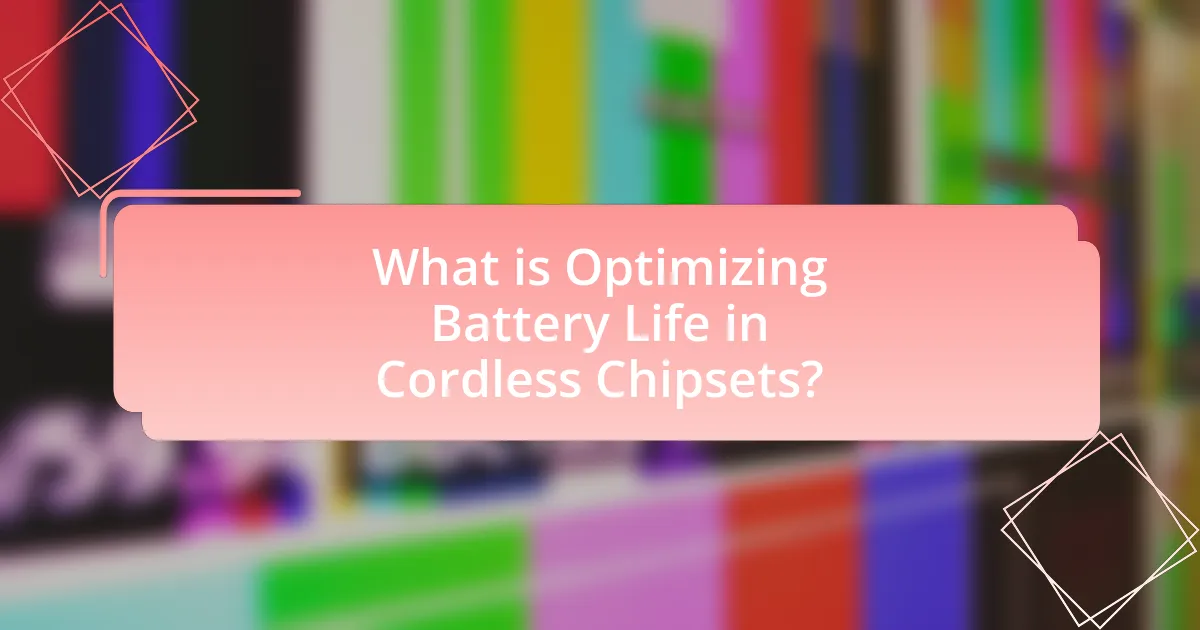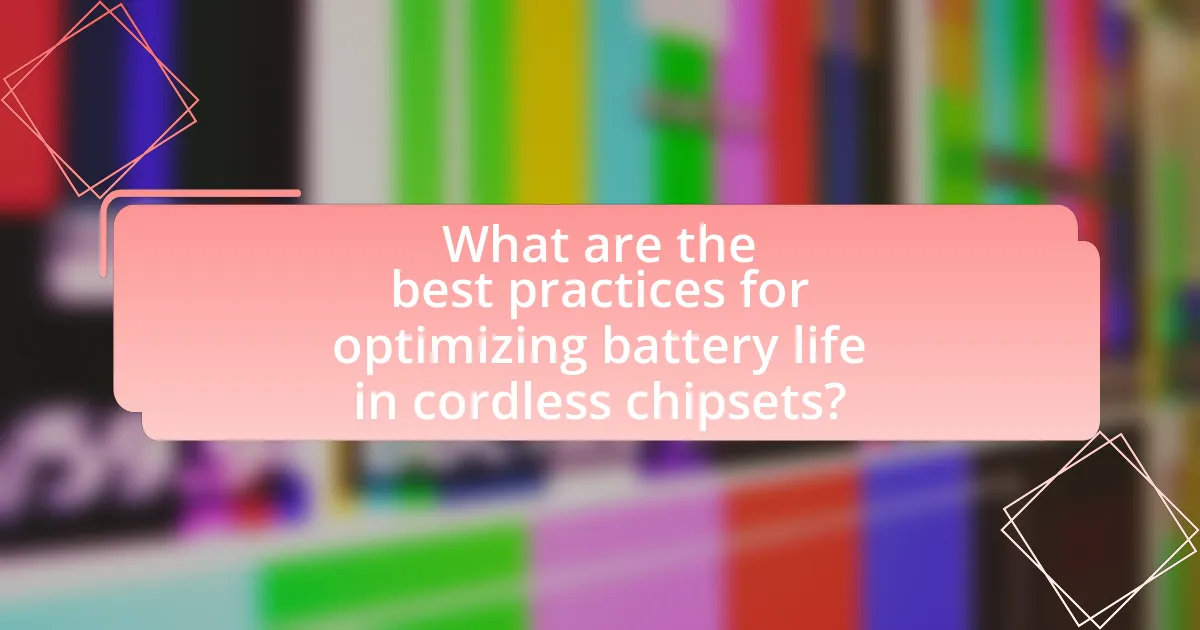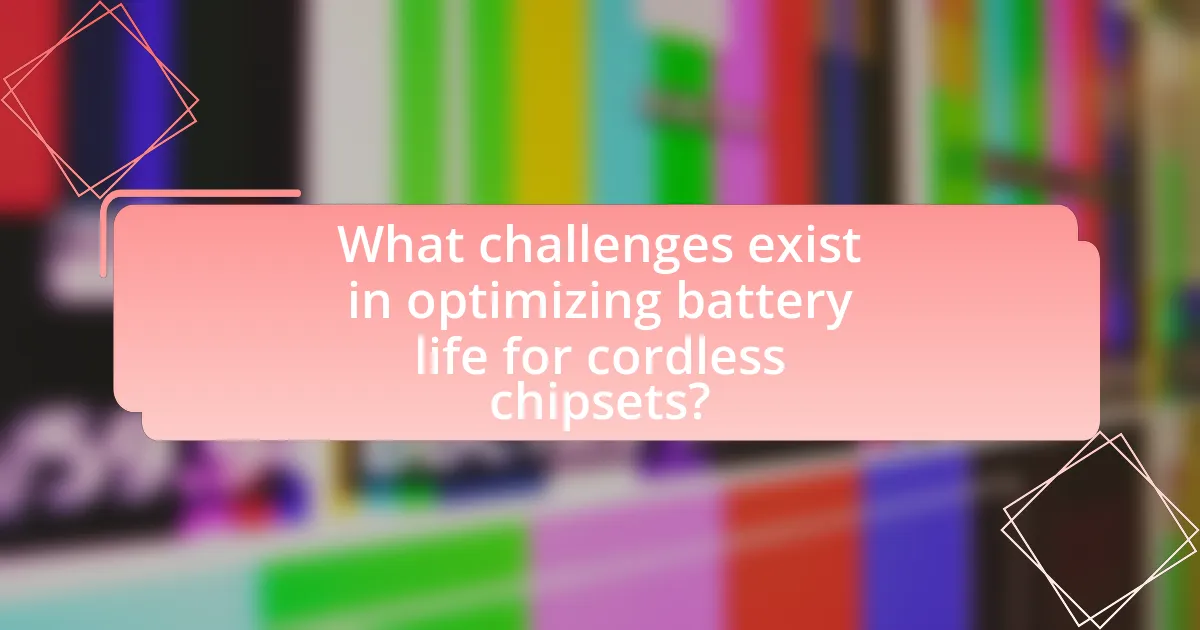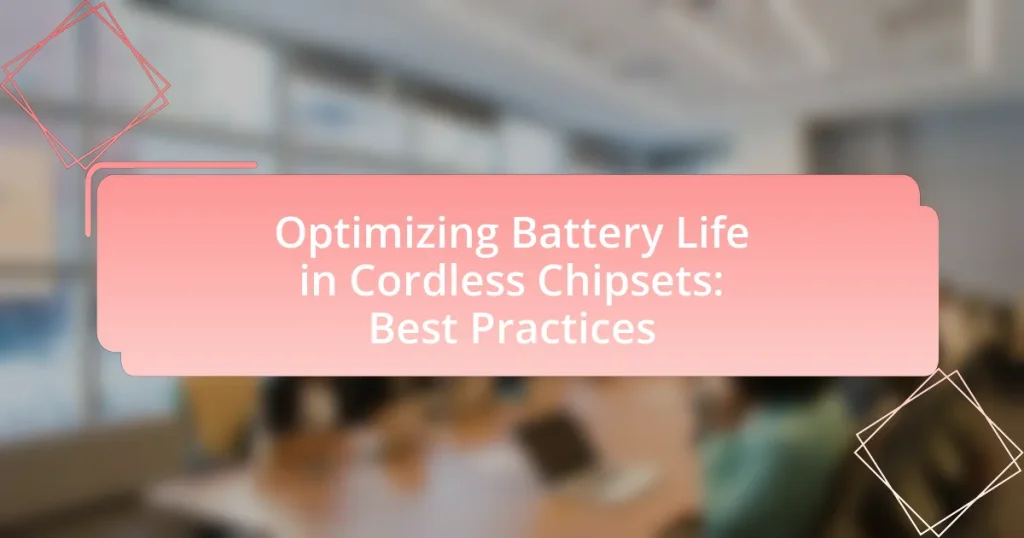Optimizing battery life in cordless chipsets is essential for enhancing energy efficiency and prolonging device usability. This article explores various strategies, including dynamic voltage scaling, power gating, and efficient sleep modes, which can significantly reduce power consumption and extend battery lifespan. It examines the impact of battery life on chipset performance, factors influencing battery consumption, and the importance of optimizing usage scenarios. Additionally, it discusses best practices for battery optimization, the role of hardware design and power management ICs, and practical tips for users to enhance battery longevity. The article also addresses challenges and common pitfalls in battery optimization, emphasizing the significance of effective management for improved user experience.

What is Optimizing Battery Life in Cordless Chipsets?
Optimizing battery life in cordless chipsets involves implementing strategies and technologies that enhance energy efficiency and prolong operational time. This can include techniques such as dynamic voltage scaling, power gating, and efficient sleep modes, which reduce power consumption during idle periods. For instance, research indicates that employing adaptive power management can lead to a reduction in energy usage by up to 30% in wireless communication devices. These methods ensure that cordless chipsets maintain performance while minimizing battery drain, ultimately extending the lifespan of the device’s battery.
How does battery life impact the performance of cordless chipsets?
Battery life significantly impacts the performance of cordless chipsets by determining their operational efficiency and functionality. When battery life is extended, cordless chipsets can maintain optimal performance levels for longer periods, enabling consistent connectivity and processing capabilities. Conversely, diminished battery life leads to reduced performance, as chipsets may throttle their processing power to conserve energy, resulting in slower data transmission and increased latency. Studies indicate that chipsets operating at lower battery levels can experience a performance drop of up to 30%, highlighting the critical relationship between battery longevity and chipset functionality.
What factors contribute to battery consumption in cordless chipsets?
Battery consumption in cordless chipsets is primarily influenced by factors such as signal strength, processing power, and usage patterns. Signal strength affects battery life because chipsets consume more power to maintain a connection in weak signal areas. Processing power impacts consumption as higher computational demands lead to increased energy use; for instance, tasks like data processing and multimedia playback require more resources. Additionally, usage patterns, including the frequency of data transmission and active versus idle states, significantly determine overall battery drain. Studies indicate that optimizing these factors can lead to improved battery efficiency in cordless chipsets.
How do different usage scenarios affect battery life?
Different usage scenarios significantly affect battery life by altering the power consumption patterns of devices. For instance, high-performance tasks such as gaming or video streaming demand more processing power and graphics rendering, leading to faster battery depletion. In contrast, low-intensity activities like reading e-books or browsing static web pages consume less energy, thereby extending battery life. Research indicates that devices can experience up to a 50% reduction in battery life during intensive usage compared to idle or low-power modes. This variance underscores the importance of optimizing usage scenarios to enhance battery longevity in cordless chipsets.
Why is optimizing battery life important for users?
Optimizing battery life is crucial for users because it directly impacts device usability and convenience. Extended battery life allows users to rely on their devices for longer periods without needing frequent recharges, enhancing productivity and overall satisfaction. According to a study by the Consumer Technology Association, 70% of users prioritize battery life when selecting electronic devices, indicating its significance in user experience. Additionally, optimizing battery life can reduce the frequency of charging cycles, which prolongs the overall lifespan of the battery, making it a cost-effective choice for users.
What are the consequences of poor battery optimization?
Poor battery optimization leads to reduced device performance and shorter battery life. When battery management is inefficient, devices may experience faster depletion of energy, resulting in frequent charging cycles. This can cause overheating, which negatively impacts the longevity of the battery and the overall device. Additionally, poor optimization can lead to increased power consumption by background applications, further draining the battery. Studies indicate that devices with optimized battery settings can extend battery life by up to 30%, highlighting the importance of effective battery management strategies.
How does battery life optimization enhance user experience?
Battery life optimization significantly enhances user experience by prolonging device usability between charges. When users can rely on their devices to last longer, they experience less frustration and increased convenience, allowing for uninterrupted usage during critical tasks. For instance, a study by the Consumer Technology Association found that 70% of users prioritize battery life when selecting a device, indicating its importance in user satisfaction. Furthermore, optimized battery life can lead to improved performance, as devices can maintain higher processing speeds without throttling due to low power. This combination of extended usability and consistent performance directly correlates with a more positive user experience.

What are the best practices for optimizing battery life in cordless chipsets?
To optimize battery life in cordless chipsets, implement power-saving modes and efficient communication protocols. Power-saving modes reduce energy consumption during idle periods, while efficient communication protocols, such as Bluetooth Low Energy (BLE), minimize power usage during data transmission. Research indicates that devices utilizing BLE can achieve up to 50% longer battery life compared to traditional Bluetooth. Additionally, optimizing the chipset’s clock speed and voltage scaling can further enhance energy efficiency, as demonstrated by studies showing that dynamic voltage and frequency scaling (DVFS) can reduce power consumption by up to 30% in mobile devices.
How can hardware design influence battery efficiency?
Hardware design significantly influences battery efficiency by optimizing power consumption through component selection and circuit architecture. Efficient hardware design minimizes energy loss by using low-power components, such as energy-efficient processors and sensors, which can reduce the overall power draw. For instance, the use of advanced semiconductor technologies, like FinFET transistors, can lead to lower leakage currents and improved performance per watt. Additionally, circuit layout and design techniques, such as minimizing the length of power distribution paths and implementing power gating, can further enhance battery efficiency by reducing resistive losses and enabling components to enter low-power states when not in use. These design choices directly correlate with improved battery life, as evidenced by studies showing that optimized hardware can lead to a 30% increase in battery performance in portable devices.
What role do power management ICs play in battery optimization?
Power management ICs (PMICs) play a crucial role in battery optimization by efficiently regulating power distribution and consumption within electronic devices. These integrated circuits manage voltage levels, control power sequencing, and minimize energy loss, which directly enhances battery life. For instance, PMICs can dynamically adjust power supply based on the device’s operational needs, reducing unnecessary power draw during idle states. This capability is supported by data indicating that devices utilizing advanced PMICs can achieve up to 30% longer battery life compared to those without such management systems.
How can component selection affect overall power consumption?
Component selection significantly impacts overall power consumption by determining the efficiency and performance characteristics of each part in a system. For instance, choosing low-power components, such as energy-efficient microcontrollers and power management ICs, can reduce the total energy required for operation. Research indicates that using components with lower quiescent current can lead to a reduction in standby power consumption by up to 50%, thereby extending battery life in cordless chipsets. Additionally, selecting components that operate at optimal voltage levels can minimize energy loss due to heat dissipation, further enhancing overall efficiency.
What software strategies can be employed for battery optimization?
Software strategies for battery optimization include adaptive power management, efficient resource scheduling, and dynamic voltage and frequency scaling (DVFS). Adaptive power management adjusts the power consumption based on the workload, ensuring that the battery is used efficiently. Efficient resource scheduling prioritizes tasks to minimize energy usage, while DVFS dynamically alters the voltage and frequency of the processor to reduce power consumption during low-demand periods. These strategies have been shown to extend battery life significantly; for instance, DVFS can reduce energy consumption by up to 30% in mobile devices, as evidenced by research from the IEEE on power management techniques.
How does firmware optimization contribute to battery life?
Firmware optimization significantly enhances battery life by improving the efficiency of power management and reducing unnecessary energy consumption. By streamlining processes and minimizing the workload on the chipset, optimized firmware can lower the frequency and duration of active states, allowing the device to spend more time in low-power modes. For instance, techniques such as adaptive voltage scaling and dynamic frequency scaling adjust the power usage based on the current workload, which has been shown to extend battery life by up to 30% in various devices. This efficiency not only prolongs usage time between charges but also contributes to the overall longevity of the battery by reducing thermal stress and wear.
What are the benefits of implementing sleep modes in chipsets?
Implementing sleep modes in chipsets significantly enhances energy efficiency, leading to extended battery life. Sleep modes reduce power consumption by allowing chipsets to enter low-power states during periods of inactivity, which can decrease energy usage by up to 90% compared to active states. This reduction in power draw is crucial for portable devices, where battery longevity is a primary concern. Additionally, sleep modes can help manage heat generation, improving the overall reliability and lifespan of the chipset.

What challenges exist in optimizing battery life for cordless chipsets?
Optimizing battery life for cordless chipsets faces several challenges, including power consumption management, thermal efficiency, and hardware limitations. Power consumption management is critical, as cordless chipsets often operate in environments with variable workloads, leading to inconsistent energy usage patterns. Thermal efficiency is another challenge; excessive heat can degrade battery performance and lifespan, necessitating advanced cooling solutions. Additionally, hardware limitations, such as the size and capacity of batteries, restrict the amount of energy that can be stored and utilized, impacting overall performance. These factors collectively complicate the optimization process, requiring innovative strategies to enhance battery longevity while maintaining functionality.
What are the common pitfalls in battery life optimization?
Common pitfalls in battery life optimization include neglecting power management settings, failing to update software, and using inefficient algorithms. Neglecting power management settings can lead to excessive energy consumption, as devices may not enter low-power states when inactive. Failing to update software can result in missed improvements in energy efficiency, as manufacturers often release updates that optimize battery performance. Additionally, using inefficient algorithms for processing tasks can drain battery life quickly, as they may require more computational resources than necessary. These pitfalls highlight the importance of actively managing settings, keeping software current, and employing efficient coding practices to enhance battery longevity.
How can manufacturers avoid over-engineering battery solutions?
Manufacturers can avoid over-engineering battery solutions by implementing a design approach that prioritizes user requirements and application-specific needs. This involves conducting thorough market research to understand the actual usage patterns and performance expectations of the end-users, which helps in defining the essential features and specifications of the battery. Additionally, manufacturers should adopt modular designs that allow for scalability and adaptability without unnecessary complexity, thereby reducing the risk of over-engineering. Evidence from industry practices shows that companies focusing on simplicity and functionality in their battery designs often achieve better performance and customer satisfaction, as seen in the success of streamlined battery solutions in consumer electronics.
What trade-offs must be considered during optimization?
During optimization of battery life in cordless chipsets, trade-offs include performance versus energy consumption, cost versus efficiency, and complexity versus usability. Performance must be balanced with energy consumption to ensure that the chipset operates effectively while maximizing battery life; for instance, higher processing speeds can drain battery faster. Cost considerations arise when selecting components that enhance efficiency, as more efficient parts may be more expensive. Additionally, increasing complexity in design can lead to better optimization but may reduce usability, making the device harder to operate or maintain. These trade-offs are critical in achieving an optimal balance between functionality and battery longevity.
How do environmental factors affect battery performance?
Environmental factors significantly impact battery performance by influencing chemical reactions within the battery. Temperature extremes can lead to reduced capacity and increased internal resistance; for instance, high temperatures can accelerate degradation processes, while low temperatures can slow down the chemical reactions necessary for energy release. Research indicates that lithium-ion batteries experience a 20% reduction in capacity at temperatures below 0°C and can lose up to 50% of their lifespan when consistently exposed to temperatures above 40°C. Humidity levels also play a role, as high humidity can lead to corrosion of battery components, further diminishing performance.
What impact does temperature have on battery life?
Temperature significantly affects battery life, with extreme temperatures leading to reduced performance and lifespan. High temperatures can accelerate chemical reactions within the battery, causing increased self-discharge rates and potential thermal runaway, while low temperatures can slow down these reactions, resulting in decreased capacity and efficiency. Research indicates that lithium-ion batteries, commonly used in cordless chipsets, can lose up to 20% of their capacity at temperatures below 0°C and may degrade faster at temperatures above 40°C. Thus, maintaining an optimal temperature range is crucial for maximizing battery longevity and performance.
How does humidity influence battery efficiency?
Humidity negatively influences battery efficiency by increasing the rate of self-discharge and corrosion within the battery. High humidity levels can lead to condensation, which may cause short circuits and degrade the internal components of batteries, particularly in lithium-ion types. Research indicates that elevated humidity can accelerate the chemical reactions that lead to capacity loss, with studies showing that batteries exposed to high humidity can lose up to 30% of their capacity over time compared to those stored in controlled environments.
What practical tips can be applied for optimizing battery life?
To optimize battery life, users should reduce screen brightness and limit background app activity. Lowering screen brightness can significantly decrease power consumption, as displays are one of the largest energy drains on devices. Additionally, restricting background app activity prevents unnecessary battery usage, as many applications continue to run processes even when not in active use. Research indicates that adjusting these settings can extend battery life by up to 30%, demonstrating the effectiveness of these practical tips.
How can users adjust settings to extend battery life?
Users can adjust settings to extend battery life by reducing screen brightness, enabling battery saver mode, and disabling unnecessary background applications. Reducing screen brightness can significantly decrease power consumption, as the display is one of the largest energy drains on devices. Enabling battery saver mode optimizes device performance by limiting background activity and reducing resource usage, which can extend battery life by up to 30% according to various studies. Disabling unnecessary background applications prevents them from consuming power when not in use, further conserving battery life.
What maintenance practices can help prolong battery lifespan?
To prolong battery lifespan, regular maintenance practices such as avoiding extreme temperatures, keeping the battery charged between 20% and 80%, and performing periodic full discharges can be effective. Extreme temperatures can cause irreversible damage to battery cells, while maintaining a charge within the specified range helps prevent stress on the battery. Additionally, full discharges every few months can recalibrate the battery management system, ensuring accurate readings and optimal performance. These practices are supported by research indicating that temperature control and charge cycles significantly impact battery longevity.


